
|
|
FYBUSH.COM/SITE OF THE WEEK
NEEDS YOUR SUPPORT! (AND YOU CAN GET A FREE TOWER SITE CALENDAR
IF YOU PLEDGE NOW...) CLICK HERE
TO LEARN MORE...
March 18-25, 2004
Riviere-du-Loup and Quebec City, Quebec
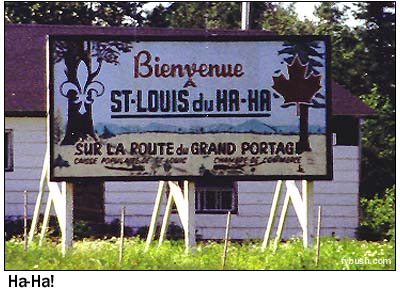 |
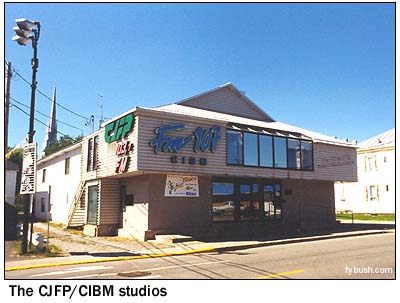 |
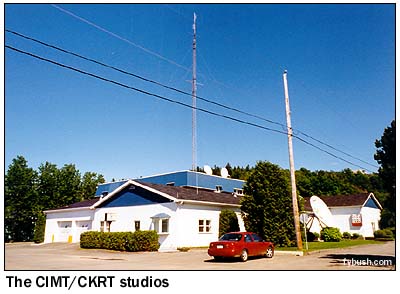 |
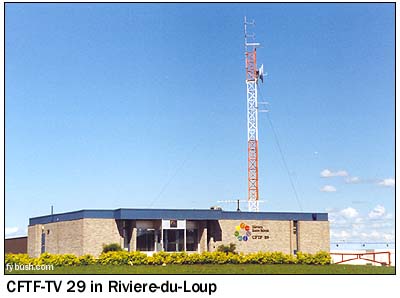 |
Our recap of a June 1998 jaunt through eastern Canada and northern New England continues this week with the sites of two Quebec cities. We entered the province from Edmundston, New Brunswick, a journey that goes up Highway 185 through the wonderfully-named community of St. Louis-du-Ha!-Ha!, which all but demanded that we stop and photograph the sign. Less than an hour after leaving Edmundston, we were in Riviere-du-Loup, a small city that hugs the south shore of the mighty St. Lawrence River. There's no AM radio left in Riviere-du-Loup, its lone station (CJFP 1400) having migrated to FM a few years earlier, and we quickly locate the downtown studios of CJFP, now on 103.7, and its sister station CIBM 107.1. This being Quebec's St. Jean Baptiste Day holiday, the city's locked up pretty tight, so no studio tour, even if we'd known how to ask in French. (No Anglophones in this part of deepest Quebec - indeed, this was the one spot on the trip where a scan of the dial produced not a single station in English!)
On the east side of town, we find the studios of the city's "twin-stick" television stations. CKRT (Channel 7) was the city's first TV station, signing on in 1963 with Radio-Canada programming.
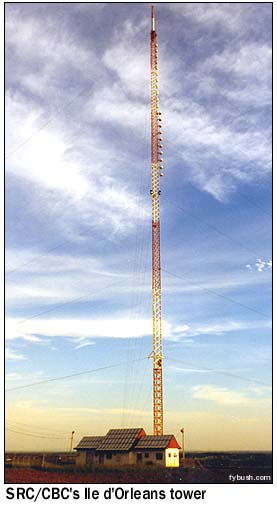 In 1978,
sister station CIMT (Channel 13) signed on with the TVA network.
Most of the programming on both channels originates in Montreal,
with just a brief nightly local news show on each. CFTF (Channel
29) was operating from an industrial park just outside of town
as an affiliate of the TQS network; that's the original (and
no longer used) TQS logo on the front of the building.
In 1978,
sister station CIMT (Channel 13) signed on with the TVA network.
Most of the programming on both channels originates in Montreal,
with just a brief nightly local news show on each. CFTF (Channel
29) was operating from an industrial park just outside of town
as an affiliate of the TQS network; that's the original (and
no longer used) TQS logo on the front of the building.
All three TV transmitters, as well as the FM stations, were on a mountaintop outside of town that we saw only from a distance and didn't try to visit. Instead, we continued down Autoroute 20 to Quebec City in search of a few sites there before sunset.
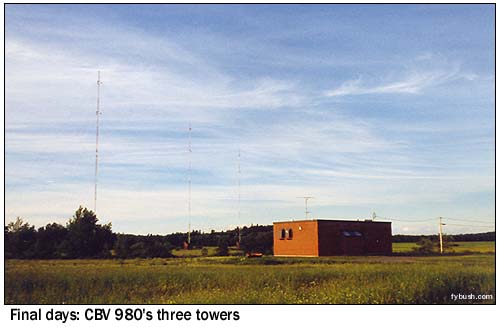
After checking in to our hotel, the historic Chateau Frontenac in Quebec's old city, we headed back across the river to the south shore and what were then the two AM sites in town. Radio-Canada's CBV (980) used three towers for its signal, while Radiomedia commercial outlet CHRC (800) pumped out 50 kW from six towers. Both stations used tight directional patterns; 800 and 980 were both reused as close by as Montreal, three hours to the west.
800 still is, as a matter of fact, but the 980 signals in both cities have gone silent. Montreal's CKGM moved to 990 many years ago (we'll see it in a future Site of the Week), while CBV's days were already numbered when we visited. CBV-FM (106.3) was already on the air that summer, and 980 went dark a few months later. The frequency may be used again soon, though; a commercial station in nearby Saint Nicolas was granted a license a couple of years ago to operate on another old Quebec City frequency, 1060, under the old Quebec calls of CJRP. It hasn't signed on yet, but it has applied to move to 980. Wonder if the old Radio-Canada site on the south shore is still standing and available for use?
(Three other old Quebec City AM frequencies are long gone as well. CKCV 1280 was another channel shared with Montreal through the use of tight DAs, while CFOM 1340 was a seventies-era bilingual top-40 outlet that was eventually forced to go all-French and later absorbed the old CFLS 920 and moved to FM on 102.9.)
Back across the bridge again for one last visit, we headed east along the river and across the bridge to the Ile d'Orleans, a few miles east of Quebec City. There we found the impressive tower of Radio-Canada's CBVT (Channel 11), complete with solar panels on the roof and two 10-bay FM antennas, one for the Radio-Canada chaine culturelle outlet on 95.3, formerly CBV-FM and now CBVX, the other for the CBC Radio One outlet on 104.7, CBVE. Neither antenna was in use by the time we visited, with the FMs having moved west of town to a mountaintop site; since our visit, channel 11 has moved as well, leaving this tower unused - if it's even still standing.
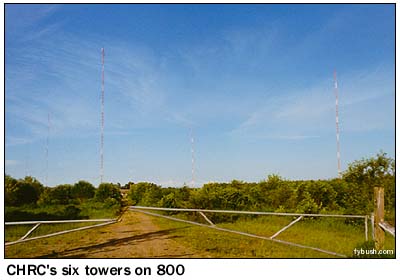 |
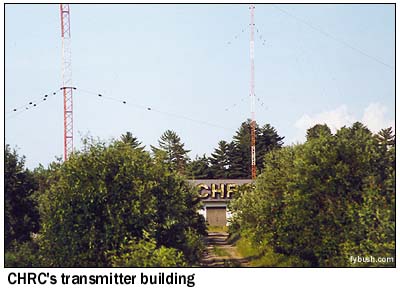 |
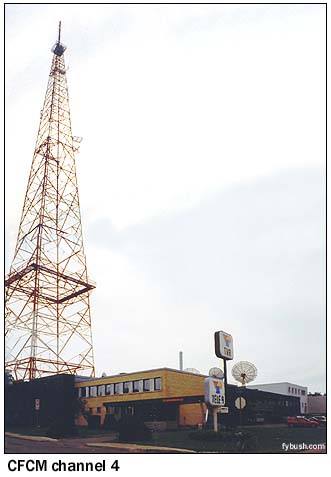 The
next morning, under much cloudier skies than the day before,
we set out to see the studios in Quebec City and neighboring
Sainte-Foy; most notably, the building on Avenue Myrand that's
home to TVA's CFCM (Channel 4), both studios and transmitter.
There's also a channel 5 signal here, carrying the CBC's English
network. For many years, this was operated locally under the
CKMI calls, but a few years ago channel 5 became a full relay
of Montreal's CBMT under the calls CBVE-TV. The CKMI license,
meanwhile, ended up in the hands of Global, which signed on a
new English-language transmitter on channel 20. CKMI in Quebec
is the nominal primary station for two relays in Montreal (channel
46) and Sherbrook (channel 11), but nearly all the viewership
for Global Quebec is on those relay transmitters. There was still
a "CKMI" sign at the Avenue Myrand building when we
visited, so Global must have at least some presence there...
The
next morning, under much cloudier skies than the day before,
we set out to see the studios in Quebec City and neighboring
Sainte-Foy; most notably, the building on Avenue Myrand that's
home to TVA's CFCM (Channel 4), both studios and transmitter.
There's also a channel 5 signal here, carrying the CBC's English
network. For many years, this was operated locally under the
CKMI calls, but a few years ago channel 5 became a full relay
of Montreal's CBMT under the calls CBVE-TV. The CKMI license,
meanwhile, ended up in the hands of Global, which signed on a
new English-language transmitter on channel 20. CKMI in Quebec
is the nominal primary station for two relays in Montreal (channel
46) and Sherbrook (channel 11), but nearly all the viewership
for Global Quebec is on those relay transmitters. There was still
a "CKMI" sign at the Avenue Myrand building when we
visited, so Global must have at least some presence there...
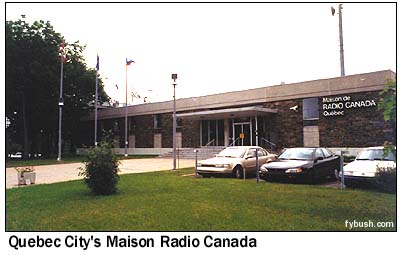
The city's commercial radio stations - all in French - were scattered among several office buildings. We found Radio-Canada out in Ste. Foy, in a low-slung building on Boulevard Laurier - and we noticed that the CBC's English newsroom (and headquarters of the "Quebec Community Network," serving all of the province's CBC transmitters outside Montreal) were in a separate facility in a Place d'Youville office building several miles away. This has recently changed, we're told, with all of the CBC/SRC operations in Quebec having just moved to a new facility in the heart of the city.
And with the clouds rolling in, we headed west for the city's master FM site - and then off to Trois-Rivieres. We'll show you those sites next week!
Still haven't ordered? It's not too late - Tower Site Calendar 2004 is STILL AVAILABLE! All orders placed by Tuesday, March 16 have now been shipped - and if you haven't yet ordered, what are you waiting for? Click here for ordering information!
- Previous Site of the Week: Edmundston, N.B. and Aroostook County, Maine
- Next Week: Quebec City and Trois-Rivieres, Quebec
- Site of the Week INDEX!
- How can you help support Site of the Week? Click here!
- Submit your suggestions for a future Site of the Week!
